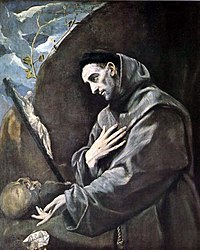 |
| Part of a series on the |
| Canon law of the Catholic Church |
|---|
|
|

In the Catholic Church, a religious order is a community of consecrated life with members that profess solemn vows. They are classed as a type of religious institute.[1]
Subcategories of religious orders are:
- monastics (monks or nuns living and working in a monastery and reciting the Divine Office)
- canons regular (canons and canonesses regular who recite the Divine Office and serve a church and perhaps a parish)
- mendicants (friars or religious sisters who live from alms, recite the Divine Office, and, in the case of the men, participate in apostolic activities); and
- clerics regular (priests who take religious vows and have an active apostolic life)
Catholic religious orders began as early as the 500s, with the Order of Saint Benedict being formed in 529. The earliest orders include the Cistercians (1098), the Premonstratensians (1120), the Poor Clares founded by Francis of Assisi (1212), and the Benedictine reform movements of Cluny (1216). These orders were confederations of independent abbeys and priories, who were unified through a loose structure of leadership and oversight.
Later the mendicant orders such as the Carmelites, the Order of Friars Minor, the Order of Preachers, the Order of the Most Holy Trinity and the Order of Saint Augustine formed. These Mendicant orders did not hold property for their Religious Communities, instead begging for alms and going where they were needed. Their leadership structure included each member, as opposed to each Abbey or House, as subject to their direct superior.
In the past, what distinguished religious orders from other institutes was the classification of the vows that the members took as solemn vows. According to this criterion, the last religious order founded was that of the Bethlehemite Brothers in 1673.[2] Nevertheless, in the course of the 20th century, some religious institutes outside the category of orders obtained permission to make solemn vows, at least of poverty, thus blurring the distinction.[citation needed]
- ^ Ryan, George (2018-01-09). "What Is a Religious Order? The Major Catholic Religious Orders Easily Explained". uCatholic.
- ^ Álvarez Gómez, CMF, Jesús (1996). Historia de la vida religiosa (in Spanish). Vol. III. Madrid: Publicaciones Claretianas. ISBN 978-8479662417.